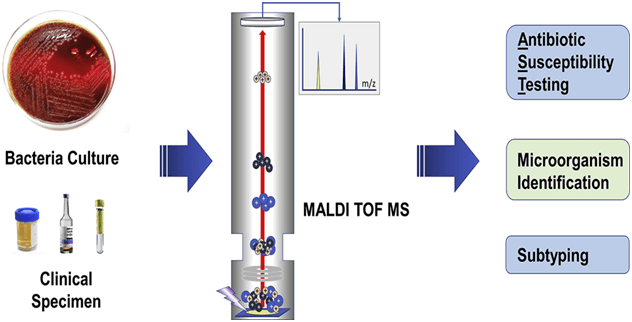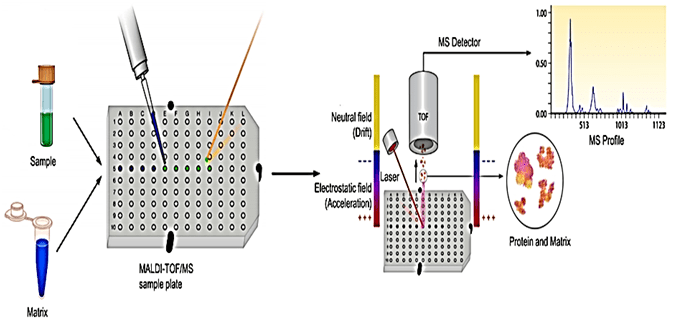Shivali Khandelwal*1 and Vishal Yadav2
1M.V.Sc. Scholar, Department of Veterinary Microbiology and Biotechnology
2M.V.Sc. Scholar, Department of Veterinary Gynaecology and Obstetrics
College of Veterinary and Animal Science, Bikaner
Rajasthan University of Veterinary and Animal Sciences, Bikaner (RAJUVAS – Bikaner),
Rajasthan – 334001, India
Introduction
MALDI-TOF MS (Matrix- Assisted Laser Desorption Ionization-Time of Flight Mass Spectrometry) is an innovative tool that’s has been recently integrated into the microbiology laboratory workflow as an easy to use, rapid, accurate, and cost effective techniquewith more specificity which has revolutionized bacterial identification in clinical microbiology laboratories. MALDI-TOF-MS identification of bacteria is based on mass signal pattern analysis algorithms and database of bacterial reference. The MALDI-TOF-MS has been used to profile bacterial proteins from cell extracts and has recently been applied to the identification of microorganisms from different genera, different species, and from different strains of the same species. The procedure provides a unique mass spectral fingerprint of the microorganisms. It can identify gram-positive, gram-negative, aerobic and anaerobic bacteria as well as mycobacteria, yeast, and molds, typically at the species level, with accuracy as good and often better than traditional methods when compared tosequencing.

Components of MALDI-TOF-MS
A mass spectrometer is composed of three functional units:
- An ionizer that converts a portion of the sample into ions.
- A mass analyzer that separates ions according to their mass-to-charge ratio (m/z).
- A detection device to monitor separated ions.
How it works?
MALDI-TOF MS identification is dependent on the ionization of microorganism proteins within the clinical specimen. MALDI -TOF ionization mechanism is a type of “soft ionization” that uses transferred energy from a laser to generate protein ions for analysis. The intrinsic property of mass spectrometry is to analyze the mass-to charge ratio (m/z) of a bioanalyte and providing spectra within minutes. During MALDI-TOF analysis, the m/z ratio of an ion is measured by determining the time required for it to travel the length of the flight tube.
The sample for analysis by MALDI MS is prepared by mixing or coating with a matrix. Matrix is a chemically saturated solution of a low-mass organic compound. The sample within the matrix is ionized in an automated mode with a laser beam. Desorption and ionization with the laser beam generate singly protonated ions from analytes in the sample. The protonated ions are then accelerated at a fixed potential, where these separate from each other on the basis of their mass-to-charge ratio. The charged analytes are then detected and measured by time of flight (TOF) analyzers. Based on the TOF information, a characteristic spectrum called peptide mass fingerprint (PMF) is generated for analytes in the sample.
Identification of microbes by MALDI-TOF MS is done by either comparing the PMF of an unknown organism with the PMFs contained in the database or by matching the masses of biomarkers of an unknown organism with the proteome database.
